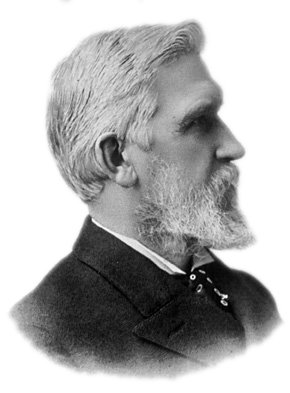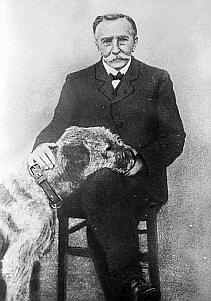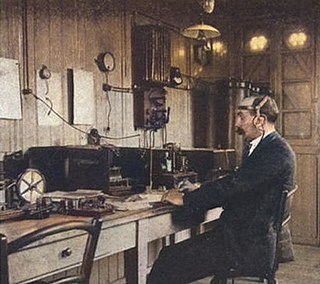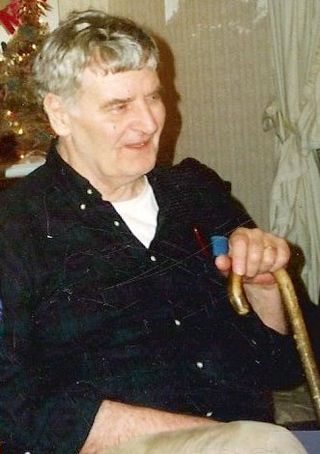Related Research Articles

Electrical telegraphs were point-to-point text messaging systems, primarily used from the 1840s until the late 20th century. It was the first electrical telecommunications system and the most widely used of a number of early messaging systems called telegraphs, that were devised to communicate text messages more quickly than physical transportation. Electrical telegraphy can be considered to be the first example of electrical engineering.

A telephone is a telecommunications device that permits two or more users to conduct a conversation when they are too far apart to be easily heard directly. A telephone converts sound, typically and most efficiently the human voice, into electronic signals that are transmitted via cables and other communication channels to another telephone which reproduces the sound to the receiving user. The term is derived from Ancient Greek: τῆλε, romanized: tēle, lit. 'far' and φωνή, together meaning distant voice. A common short form of the term is phone, which came into use early in the telephone's history.

Telegraphy is the long-distance transmission of messages where the sender uses symbolic codes, known to the recipient, rather than a physical exchange of an object bearing the message. Thus flag semaphore is a method of telegraphy, whereas pigeon post is not. Ancient signalling systems, although sometimes quite extensive and sophisticated as in China, were generally not capable of transmitting arbitrary text messages. Possible messages were fixed and predetermined, so such systems are thus not true telegraphs.

Wireless telegraphy or radiotelegraphy is transmission of text messages by radio waves, analogous to electrical telegraphy using cables. Before about 1910, the term wireless telegraphy was also used for other experimental technologies for transmitting telegraph signals without wires. In radiotelegraphy, information is transmitted by pulses of radio waves of two different lengths called "dots" and "dashes", which spell out text messages, usually in Morse code. In a manual system, the sending operator taps on a switch called a telegraph key which turns the transmitter on and off, producing the pulses of radio waves. At the receiver the pulses are audible in the receiver's speaker as beeps, which are translated back to text by an operator who knows Morse code.

In telecommunications and computer networking, multiplexing is a method by which multiple analog or digital signals are combined into one signal over a shared medium. The aim is to share a scarce resource – a physical transmission medium. For example, in telecommunications, several telephone calls may be carried using one wire. Multiplexing originated in telegraphy in the 1870s, and is now widely applied in communications. In telephony, George Owen Squier is credited with the development of telephone carrier multiplexing in 1910.

The telautograph is an ancestor of the modern fax machine. It transmits electrical signals representing the position of a pen or tracer at the sending station to repeating mechanisms attached to a pen at the receiving station, thus reproducing at the receiving station a drawing, writing, or signature made by the sender. It was the first such device to transmit drawings to a stationary sheet of paper; previous inventions in Europe had used a constantly moving strip of paper to make such transmissions and the pen could not be lifted between words. Surprisingly, at least from a modern perspective, some early telautographs used digital/pulse-based transmission while later more successful devices reverted to analog signaling.

Elisha Gray was an American electrical engineer who co-founded the Western Electric Manufacturing Company. Gray is best known for his development of a telephone prototype in 1876 in Highland Park, Illinois. Some recent authors have argued that Gray should be considered the true inventor of the telephone because Alexander Graham Bell allegedly stole the idea of the liquid transmitter from him. Although Gray had been using liquid transmitters in his telephone experiments for more than two years previously, Bell's telephone patent was upheld in numerous court decisions.

This timeline of the telephone covers landline, radio, and cellular telephony technologies and provides many important dates in the history of the telephone.

Electronic media are media that use electronics or electromechanical means for the audience to access the content. This is in contrast to static media, which today are most often created digitally, but do not require electronics to be accessed by the end user in the printed form. The primary electronic media sources familiar to the general public are video recordings, audio recordings, multimedia presentations, slide presentations, CD-ROM and online content. Most new media are in the form of digital media. However, electronic media may be in either analogue electronics data or digital electronic data format.

The invention of the telephone was the culmination of work done by more than one individual, and led to an array of lawsuits relating to the patent claims of several individuals and numerous companies. Notable people including in this were Antonio Meucci, Elisha Gray and Alexander Graham Bell.
John Stone Stone was an American mathematician, physicist and inventor. He initially worked in telephone research, followed by influential work developing early radio technology, where he was especially known for improvements in tuning. Despite his often advanced designs, the Stone Telegraph and Telephone Company failed in 1908, and he spent the remainder of his career as an engineering consultant.

The history of telecommunication began with the use of smoke signals and drums in Africa, Asia, and the Americas. In the 1790s, the first fixed semaphore systems emerged in Europe. However, it was not until the 1830s that electrical telecommunication systems started to appear. This article details the history of telecommunication and the individuals who helped make telecommunication systems what they are today. The history of telecommunication is an important part of the larger history of communication.

The invention of radio communication was preceded by many decades of establishing theoretical underpinnings, discovery and experimental investigation of radio waves, and engineering and technical developments related to their transmission and detection. These developments allowed Guglielmo Marconi to turn radio waves into a wireless communication system.

The carbon microphone, also known as carbon button microphone, button microphone, or carbon transmitter, is a type of microphone, a transducer that converts sound to an electrical audio signal. It consists of two metal plates separated by granules of carbon. One plate is very thin and faces toward the speaking person, acting as a diaphragm. Sound waves striking the diaphragm cause it to vibrate, exerting a varying pressure on the granules, which in turn changes the electrical resistance between the plates. Higher pressure lowers the resistance as the granules are pushed closer together. A steady direct current is passed between the plates through the granules. The varying resistance results in a modulation of the current, creating a varying electric current that reproduces the varying pressure of the sound wave. In telephony, this undulating current is directly passed through the telephone wires to the central office. In public address systems it is amplified by an audio amplifier. The frequency response of most carbon microphones, however, is limited to a narrow range, and the device produces significant electrical noise.

George H. Sweigert (1920–1999) is credited as the first inventor to patent the cordless telephone.
The Elisha Gray and Alexander Graham Bell controversy concerns the question of whether Gray and Bell invented the telephone independently. This issue is narrower than the question of who deserves credit for inventing the telephone, for which there are several claimants.

This history of the telephone chronicles the development of the electrical telephone, and includes a brief overview of its predecessors. The first telephone patent was granted to Alexander Graham Bell in 1869.
A water microphone or water transmitter is based on Ohm's law that current in a wire varies inversely with the resistance of the circuit. The sound waves from a human voice cause a diaphragm to vibrate which causes a needle or rod to vibrate up and down in water that has been made conductive by a small amount of acid. As the needle or rod vibrates up and down in the water, the resistance of the water fluctuates which causes alternating current in the circuit. For this to work, the resistance of the water must vary substantially over the short distance the needle or rod vibrates. Acidulated water works well because only a small amount of acid is added. If one millimeter of acidulated water has a resistance of 100 ohms, two millimeters would have 200 ohms which would produce enough alternating current to transmit audio signals in thousands of feet of wire. Mercury will not work because the resistance of one millimeter of mercury is less than a tenth of an ohm and vibration of a needle in mercury would produce negligible alternating current.
Marcellus Bailey was an American patent attorney who, with Anthony Pollok, helped prepare Alexander Graham Bell's patents for the telephone and related inventions.
Anthony Pollok was an American patent attorney who, with Marcellus Bailey, helped prepare Alexander Graham Bell's patents for the telephone and related inventions.
References
- Notes
- ↑ Standage, pp. 195–199
- Bibliography
- Standage, Tom, The Victorian Internet, Berkley Books, New York (Penguin), 1998, ISBN 0-425-17169-8
- D. Robertson. The Great Telephone Mystery, IEEE Review, Feb. 2006, Volume: 52, Issue: 2, pp. 44– 48, ISSN 0953-5683, INSPEC Accession Number: 8770451, Current Version Published: 2006-02-27.
- Brooke Clarke. Telephone Patents